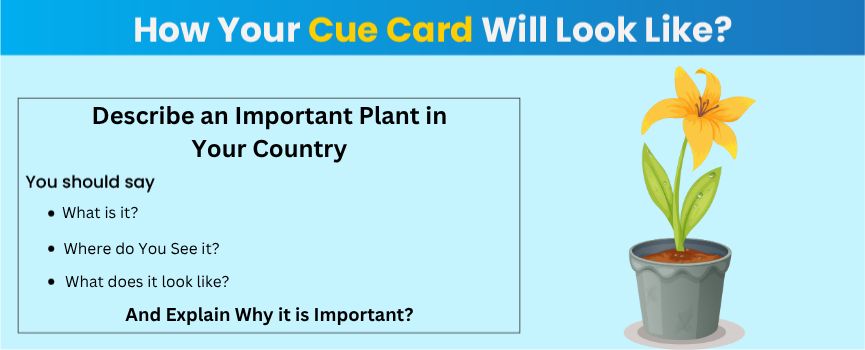The IELTS speaking test is a one-to-one interaction with an examiner. It is designed to evaluate your ability to speak fluently in English. The duration for this section is 11-14 minutes. Out of all the various tasks, the cue card is the highest scoring but also the most difficult task. In the cue card, you are required to speak on a specific topic for a fixed time. Thus, in this blog, we present a few samples of cue cards on the topic of describing an important plant in your country. It is followed by substantial lexical resources, follow-up questions, and tips to achieve a brilliant score.

Table of Contents
In IELTS cue cards, you need to speak on the given topic with a prompt called cue card. It consists of relevant information on the particular topic and related questions. You will have a total of one minute to prepare and make notes on the given topic. Later on, speak about the topic for the next 2 minutes.
The subject of the topic may vary, such as places, objects, situations, or incidents. To get command over the task, you can practice with the following cue card topic in IELTS speaking part 2 on describing an important plant in your country. However, logical answering needs a specific approach and outline. You can refer to the next section for more information.
This is a tricky question for students, but you don’t need to worry too much about it. If you understand the requirements of the topic, then answering the IELTS cue card will no longer be a difficult task. Hence, in this blog on the topic called Describe an important plant in your country, you need to start with a brief introduction and then deal with the four types of questions, as follows:
Below is the image of the cue card "describes an important plant in your family", which you will receive during the IELTS exam.
This is the first sample to describe an important plant in your country- neem. Many cultural, traditional or medicinal significances are associated with neem.
In my country, India, plants hold immense importance, and I would like to discuss the neem plant. Neem is famous in my country. The leaves of neem are very bitter, but the benefits are long-lasting and impressive.
The scientific name of neem is ‘Azadirachta indica’; however, in India, it is referred to as the ‘village pharmacy’. It contains numerous medicinal properties, for example, being used to cure chicken pox. People use a paste made from neem leaves for skin care. The branches of the tree are used for cleaning the teeth, especially in rural areas. Moreover, it is important for our culture, too. In India, especially in Hinduism, neem is for religious belief, and you can see it around every corner of the street.
Neem can often be seen in rural areas, such as around temples, verandas, homes, and streets. It is something that can be easily grown and requires minimal effort. Thus, most people prefer to keep growing, and it requires minimal effort as well. When I visit my grandmother’s home in the village during vacation, I see a neem tree in the backyard. There is also another plant related to neem, curry leaves. It is sweeter. Curry leaves are famously used in South Indian cuisine. Thus, neem is a crucial plant in my country.
The neem tree is 20 meters tall and has a dense canopy of lush green leaves. Its bark is rough and dark. It features small, white flowers that bloom in clusters, offering a pleasant fragrance. Neem has various medicinal properties and ecological benefits. It is found in abundance near the roadside, in fields, and in gardens. It is also used in agriculture. The neem seeds are used for insecticide sprays, as manure for the soil, and for many other purposes.
Neem is important for its medicinal uses, such as skin treatment and immunity booster. In addition to this, it plays a crucial role in agriculture as a pesticide and benefits farming practices. Neem is used due to its natural Ayurvedic properties, and therefore, it is found in abundance throughout most of the country.
So, I can say that the neem tree has a special place in the heart of our country. I wish that the whole world would recognize the importance of the Ayurvedic and economic benefits of our ancient tree, neem.
The Tulsi plant holds a special place in Indian's hearts. So, let's get started with another sample: describing an important plant in your country.
Every Indian have at least one Tulsi plant in their home, as it has a divine connection, and people assume that the plant is a deity. Therefore, Indians worship Tulsi on a daily basis. Let's get started with the discussion.
The scientific name of Tulsi is Ocimum sanctum or Ocimum tenuiflorum. Tulsi is a part of the Lamiaceae family and is known as the "queen of plants". It has medicinal properties and is known as "the mother medicine of nature". Every part of the plant can be used for Therapeutic purposes.
I often see Tulsi, also known as holy basil, in and around Hindu homes. At my house, it's placed in the courtyard or near the entrance, usually grown in pots or in a special masonry structure called a Tulsi Vrindavan. I've also noticed it in temple courtyards and gardens, especially in areas dedicated to Lord Vishnu or Krishna. During my visit to Varanasi, one of the oldest cities in Uttar Pradesh, I came across Tulsi Ghat — a place that beautifully reflects the cultural richness, legacy, and spiritual importance of Tulsi in Hindu tradition.
It is a green or purple perennial shrub with aromatic leaves and hairy stems. The height of the Tulsi plant is typically between 30-60 cm. However, it can grow up to 1 meter. It has three types of varieties, as given below:
Tulsi has various medicinal properties that are used to cure diseases, such as a common cough, and it is used in other treatments. In my childhood, my grandparents used to explain to me the spiritual importance of the Tulsi tree and advised me to worship the tree for divine blessings.
Thus, Tulsi is not just a plant in India; rather, it has a direct connection to the mind and soul of the people. I have been growing by observing my parents and grandparents worship Tulsi and treat it with reverence. As I grew up, I also discovered many.
This is the third sample to describe an important plant in your country, where I will discuss the banana plant.
Plantains or banana trees are like mini trees with leaves that look like branches. Banana trees are present in almost every house. Its leaf is an alternative option for a plate for food. The flower of the banana plant is considered a vegetable.
I’ve learned that the banana plant belongs to the Musa species. Even though it looks like a tree, it’s actually a large, herbaceous flowering plant. What really fascinates me is how it’s formed — with tightly packed leaf sheaths and big, oblong leaves. I also found out that this plant is native to the tropical regions of Southeast Asia and Australia.
In my country, the banana tree is found almost everywhere, in almost every house. It is important for daily households. The banana plant has high nutritional value, hence it requires less amount of water, so it is easy to maintain and grow for the plant.
Banana tree is a large herbaceous plant. It forms a pseudostem from tightly packed leaf sheaths. These sheaths create a sturdy, trunk-like structure that can support the plant and the fruits. The plant has large, oblong, bright green leaves that are typically 2-3 feet wide and up to 9 feet long.
The leaves of the banana can be used as plates for food and for wrapping food. Moreover, the banana plant is used for preparing various dishes. It has high nutritional value. It requires less amount of water, thus it is easy to maintain and grow the plantain.
Thus, the banana plant is useful for cooking dishes and other purposes as well. Its leaves, stems are used for reusable purposes. Hence, it is the most important item in an Indian home.
Lexical resources are the criteria that decide your score in the IELTS speaking part 2. Thus, it is important to use different vocabulary for IELTS exam to make a long-lasting impression on the examiner. Follow the table below for lexical sources, which will help you score better on the English language test.
| Vocabulary Words | Meaning |
|---|---|
| Backyard | An area behind a house |
| Cuisines | A style or method of cooking |
| Ecological | Study of living organism interaction with each other |
| Insecticide | a substance that is used for killing insects |
| Pesticide | a chemical substance that is used for killing animals |
| Abundance | a very large quantity of something |
| Significance | the importance or meaning of something |
| Fragrance | a pleasant smell |
| Asthma | a medical condition that makes breathing difficult |
| Pseudostem | the part of the banana plant that looks like a trun |
| Nutritional | a food substance your body can use |
Follow-up questions are asked by the examiner after the IELTS speaking section. Have a quick view.
1. What Are Some Other Medicinal Plants in Your Country?
Answer: In addition to this, aloe Vera, turmeric, Amla and Giloy are the medicinal plants. Each has different health benefits and is used for traditional remedies. For instance, aloe Vera is great for skin health, Amla is good for the hair, eyes and digestion. Thus, India is a land for Ayurveda and ancient herbs.
2. How Do People in Your Country Use Neem in Their Daily Lives?
Answer: People in India use neem in different ways, for instance, for making neem oil for skin treatments, and herbal teas. Moreover, the neem branches are used for dental hygiene. It is believed that this type of practice promotes oral health.
3. Can You Explain the Spiritual Significance of Tulsi in More Detail?
Answer: Tulsi is a sacred plant in Hinduism and is considered near to the goddess. Tulsi is a symbol of purity and devotion. Most of the Indian families worship the plant daily for peace and prosperity. It is the common belief that the Tulsi plant at home purifies the environment.
4. Are There Any Cultural Festivals Related to Plants in Your Country?
Answer: Yes, several cultural festivals celebrate plants. For instance, Pongal in South India honors the harvest. This time, people decorate their homes and deliver honors for the harvest. It reflects the importance of agriculture and plants in our culture.
5. How Do You Think Urbanisation Affects These Important Plants?
Answer: Urbanisation poses a serious threat to plants like neem and mango. As the urban population increases, green space is getting reduced, leading to the loss of greenery. It affects the biodiversity and diminishes the cultural practices associated with these plants, highlighting the need for sustainable urban planning.
To get command over the IELTS speaking part 2, you have to frame your approach to score well. However, the strategy can vary from person to person, yet to help you, we have listed some common tips:
Wrapping up! The cue card topic in the IELTS speaking section describes an important plant in your country, which sounds like the easiest task. However, to attempt this type of question, you must thoroughly understand the samples and follow-up questions. Try to keep your communication more engaging, which creates a strong impression.
Thus, if you need more topics for cue cards and need assistance, you can get help from our experts at Gradding.com. They offer online IELTS classes, providing high-quality materials, IELTS mock tests, and more to help students become proficient in solving cue cards.

We are available in :
BangaloreAhmedabadJaipurHyderabadKeralaPuneChandigarhMumbaiGurgaonChennaiKolkataTrivandrumNoidaKochiCalicutKottayamKollamThrissurIndoreUdaipurdisclaimer:logos and other registered trademarks of universities used on this platform are held by their respective owners. Gradding does not claim ownership or association on them, and their use is purely for informational and illustrative purposes.



